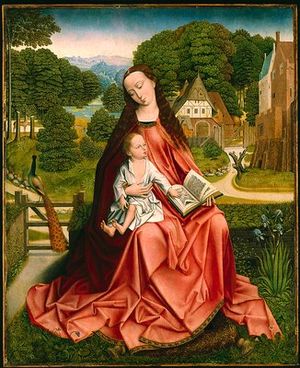Master of the Embroidered Foliage
- Master of the Embroidered Foliage
-
Master of the Embroidered Foliage (active 1480 – 1510) was a Netherlandish painter or a group of painters who worked out of Bruges and Brussels.
In 1926 the German art historian Max Jakob Friedländer attributed a group of paintings of the Virgin and Child in a landscape, in identical poses to "Master of the Embroidered Foliage." The foliage painted in these works was likened by Friedländer to the repeated pattern of stitches in embroidery, thus the unusual name for the artist. The paintings show elements of previous works by Rogier van der Weyden and Hans Memling. There are at least five versions, including three in the United States: Philadelphia Museum of Art, Minneapolis Institute of Arts, and Clark Art Institute. The other two are at Groeningemuseum, Bruges, and at Musée des Beaux-Arts, Lille.
The Clark Art Institute concludes their investigation of the paintings as follows: Our analysis, based on laboratory study and consideration of fifteenth-century workshop practices, demonstrates that these panels were all produced between 1482 and the early 16th century not by one but by several artists, perhaps sharing a common template for the main figures. Unless further conclusive evidence comes to light, however, we will continue to attribute the paintings to the Master of the Embroidered Foliage, while acknowledging that this is a catch-all name referring to a number of painters active in Brussels and Bruges in the late 15th century.[1].
External links
Categories:
- Flemish painters
- Renaissance painters
- Early Netherlandish painters
- Anonymous artists
- Netherlandish painter stubs
Wikimedia Foundation.
2010.
Look at other dictionaries:
Meister mit dem gestickten Laub — Der Meister mit dem gestickten Laub[1] (fr. Maître au feuillage brodé[2], engl. Master with the Embroidered Foliage[3]) war ein um 1500 in Flandern tätiger Maler. Mit großer Sicherheit hatte er in Brüssel seine Werkstatt.[4] Inhaltsverzeichnis 1… … Deutsch Wikipedia
Early Netherlandish painting — Early Netherlandish paintingPanofsky, Erwin. Early Netherlandish Painting . London: Harper Collins, 1971 ISBN 0 06 430002 1] is the work of those painters who were active in the Low Countries during the 15th and early 16th century Northern… … Wikipedia
Cathedral of Toledo — The Cathedral of Saint Mary of Toledo, also called Primate Cathedral of Toledo, is a church in Spain. The seat of the Archdiocese of Toledo, it is one of the three 13th century High Gothic cathedrals in Spain and is considered to be the magnum… … Wikipedia
South Asian arts — Literary, performing, and visual arts of India, Pakistan, Bangladesh, and Sri Lanka. Myths of the popular gods, Vishnu and Shiva, in the Puranas (ancient tales) and the Mahabharata and Ramayana epics, supply material for representational and… … Universalium
Portal:Textile arts — Wikipedia portals: Culture Geography Health History Mathematics Natural sciences People Philosophy Religion Society Technology … Wikipedia
Latin American art — Introduction artistic traditions that developed in Mesoamerica, Central America, and South America after contact with the Spanish and Portuguese beginning in 1492 and 1500, respectively, and continuing to the present. This article… … Universalium
Tree of Jesse — The oldest complete Jesse Tree window is in Chartres Cathedral, 1145. The Tree of Jesse is a depiction in art of the Ancestors of Christ, shown in a tree which rises from Jesse of Bethlehem, the father of King David; the original use of the… … Wikipedia
furniture — furnitureless, adj. /ferr ni cheuhr/, n. 1. the movable articles, as tables, chairs, desks or cabinets, required for use or ornament in a house, office, or the like. 2. fittings, apparatus, or necessary accessories for something. 3. equipment for … Universalium
rug and carpet — Any decorative textile normally made of a thick material and intended as a floor covering. Floor coverings made of plaited rushes date from the 5th or 4th millennium BC. Carpets were first made in central and western Asia as coverings for earthen … Universalium
Southeast Asian arts — Literary, performing, and visual arts of Myanmar (Burma), Thailand, Laos, Cambodia, Vietnam, Malaysia, Singapore, and the Philippines. The classical literatures of Southeast Asia can be divided into three major regions: the Sanskrit region of… … Universalium

